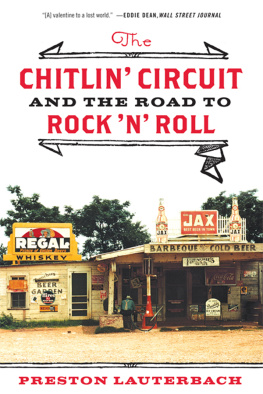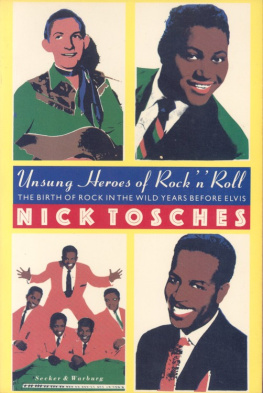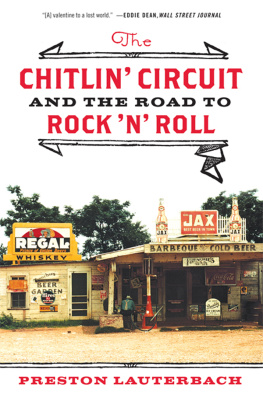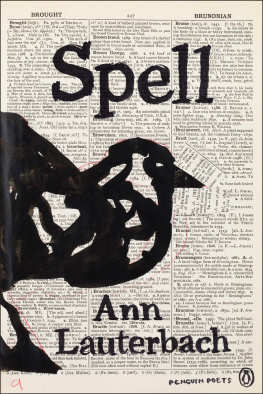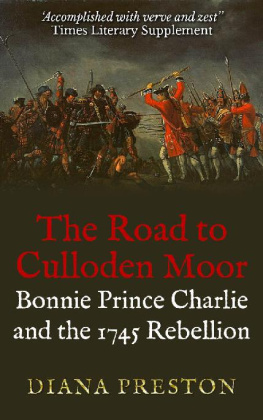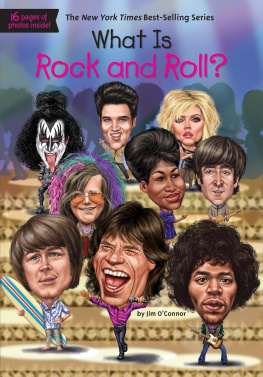Preston Lauterbach - The Chitlin Circuit: And the Road to Rock n Roll
Here you can read online Preston Lauterbach - The Chitlin Circuit: And the Road to Rock n Roll full text of the book (entire story) in english for free. Download pdf and epub, get meaning, cover and reviews about this ebook. year: 2011, publisher: W. W. Norton & Company, genre: Detective and thriller. Description of the work, (preface) as well as reviews are available. Best literature library LitArk.com created for fans of good reading and offers a wide selection of genres:
Romance novel
Science fiction
Adventure
Detective
Science
History
Home and family
Prose
Art
Politics
Computer
Non-fiction
Religion
Business
Children
Humor
Choose a favorite category and find really read worthwhile books. Enjoy immersion in the world of imagination, feel the emotions of the characters or learn something new for yourself, make an fascinating discovery.
- Book:The Chitlin Circuit: And the Road to Rock n Roll
- Author:
- Publisher:W. W. Norton & Company
- Genre:
- Year:2011
- Rating:4 / 5
- Favourites:Add to favourites
- Your mark:
- 80
- 1
- 2
- 3
- 4
- 5
The Chitlin Circuit: And the Road to Rock n Roll: summary, description and annotation
We offer to read an annotation, description, summary or preface (depends on what the author of the book "The Chitlin Circuit: And the Road to Rock n Roll" wrote himself). If you haven't found the necessary information about the book — write in the comments, we will try to find it.
The Chitlin Circuit: And the Road to Rock n Roll — read online for free the complete book (whole text) full work
Below is the text of the book, divided by pages. System saving the place of the last page read, allows you to conveniently read the book "The Chitlin Circuit: And the Road to Rock n Roll" online for free, without having to search again every time where you left off. Put a bookmark, and you can go to the page where you finished reading at any time.
Font size:
Interval:
Bookmark:
My correspondences and friendships with family members of some of the characters who appear in The Chitlin Circuit and the Road to Rock n Roll enriched both the story and my life. Very special thanks to Don Robey Jr. in Houston. St. Clair Alexander shared memories of his brother John Johnny Ace Alexander in Memphis. Dorothy Parrott Barness niece Joyce Taylor, of Los Angeles, introduced me to Walter Barness niece Toya Johnson of Chicago. Both ladies shared family stories that appear here, and Ms. Johnson provided photographs of Mr. Barnes. Last but foremost, words cannot express my gratitude to Denver Fergusons daughter Carole Ferguson Finnell of Indianapolis and her family.
I was equally fortunate to encounter numerous able-minded archivists and librarians while researching the story. Not only did they provide access to important documents, but also they shared enthusiasm for and knowledge of their places and specialties that added important intangibles to this project. Thanks to the staffs at the Auburn Avenue Research Library in Atlanta and the Houston Metropolitan Research facility in Houston; Wilma Gibbs and Susan Sutton at the Indiana Historical Society in Indianapolis; Portia Maultsby, Brenda Strauss-Nelson, and Ronda Sewald at the Archives of African American Music and Culture at Indiana University in Bloomington; Lynn Abbott at Tulane Universitys William Ransom Hogan Archive of New Orleans Jazz; Muriel Jackson at the Middle Georgia Archives at the Washington Memorial Library in Macon; my old buddy Greg Johnson in the Blues Archive at Ole Miss (University of Mississippi); Ed Frank in Special Collections at the University of Memphis Library; and G. Wayne Dowdy of the Memphis Public Library, whose encouragement and insight were especially inspiring.
Other point people provided indispensable information and contacts on this storys many fronts. Thanks to Roosevelt Jamison in Memphis; Christina Ayon, Dave Brewer, Paul Mullins of Indiana UniversityPurdue University Indianapolis, and retired Indianapolis police officer Richard Crenshaw in Indianapolis; Roger Wood in Houston; R. J. Smith, an L.A. guy who knows where to go in Macon, Georgia; Van Siggers of Tunica, Mississippi; and Allan Hammons of the B.B. King Museum in Indianola, Mississippi.
Dan Kochakian, John Broven, Mike Haralambos, Galen Gart, Billy Vera, and Charles Dr. Rock White have been writing about black music for longer than Ive been breathing, and all were kind enough to answer questions and share their research or track down information, as did my valued friend and erstwhile co-conspirator Red Kelly. Mike Lydon graciously permitted me to listen to interviews he conducted while working on his excellent Ray Charles biography. Juke Blues editor Cilla Huggins and Oxford American editorial assistant Meghan Plummer came through with important data at the last minute.
Megan Pugh provided a writers closest allies: high-grade caffeine and insightful proofreading. Scott Barretta has been both a great and a terrible influence, and Ive enjoyed both immensely. Historians Ted Ownby and Ed Ayers provided writing advice and research guidance on earlier versions of this project that retained usefulness throughout its evolution.
Im indebted to Jim ONeal for making connections for me to get this project going, for sharing his own research and vast knowledge, and for all the thought-provoking e-mail and conversations. Hes not one to beat his own drum, so Ill do it for him. Jim, through his work with Living Blues magazine and as a record producer and independent scholar, has committed his life to the history of the blues and its cousins, and has made incalculably important contributions to the historical record of black music.
Im blessed to be working with agent Paul Bresnick and editor Tom Mayer, both of whom live in defiance of the whats wrong with publishing today clichs. Mayers assistant Denise Scarfi helped out, and Mary Babcock provided expert copyediting.
My friends Emerson Able Jr., Howard Grimes, and the late Isaac Sax Kari Toombs made this book possible and changed my life, and I dont think I can thank them enough for all theyve done.
Finally, my wife, Elise, and our daughter, Maggie Grace, enlivened motel rooms in nondescript places, and kept me laughing.
Preston Lauterbach
Memphis, Tennessee
About the Author

Justin Fox Burks
Preston Lauterbach lives with his wife
and children in Memphis, Tennessee.

This ought to be where the Royal Creolians, International Sweethearts of Rhythm, Chickenshackers, Mighty Mighty Men, Tempo Toppers, and Famous Flames face off in an apocalyptic Battle of the Blues, but Im afraid closing the chitlin circuit is not so simple. Such a slippery organization does not just topple. Headlining performers died or went cold, big-time promoters quit, posh nightclubs shut down, and the circuit as a whole outlived all such strife. From Walter Barnes winking at dancers as he flourished his baton on the Afro Auditorium stage in Yazoo City, Mississippi, to Marvin Candy Licker Sease flaring his tongue at the Agri-Center crowd in Greenwood, Mississippi, seventy-five years later, no underground American music scene has survived nearly as long or accomplished as much as the chitlin circuit.
This first twenty years on the circuit, from Barnes, Fatha Hines, Tiny Bradshaw, and Lucky Millinder to B.B. King, Little Richard, and James Brown was only the beginning. And rock n roll, though a key aspect of this story, had been no more of a deliberate destination for the chitlin circuit than it was the circuits end point. But the chitlin circuit is in sharper focus now than it was back then. We can view its evolution through a wide angle, clearly seeing important events and monumental changes that may not have been recognized as such in their chaotic times. We can see how a cultural fad for Louis Jordans small band and harsh postWorld War II economic conditions forced black promoters to turn from big, expensive swing bands to small, cheap, loud combos, thus revolutionizing black music. We can see how darktowns lively atmosphere inspired violent, sexual, hedonistic lyricsRoy Browns Good Rockin Tonight and Boogie at Midnightand how it all unwittingly, incrementally shaped rock n roll.
We can also now recognize how the circuit was transformed as black rock n roll went mainstream in the mid-1950s. The tour business, which had been the leading moneymaker in black music during the circuits first twenty years, was demoted.
Back in the 1930s, ill-fated bandleader Walter Barnes made no money, for himself or anyone else, from his few recording opportunities, but he earned his entire salary in the dance hall. The same rule applied to Denver Fergusons artists: his top drawing act during the World War II years, the Carolina Cotton Pickers, never made record one, much less their first dime from anything other than a dance. Louis Jordan couldnt reach stardom through records and cabaret residencies during the same period, and hit the chitlin circuit in the summer of 1942 to build his audience and fatten his pockets. T-Bone Walker, Joe Turner, Wynonie Harris, and Cecil Gant made outstanding records after the war, but still made their livings on the circuit. Consequently, the money and power in the for-black music business were with agents, promoters, and club owners, people like Denver Ferguson, Don Robey, and then Ben Bart and Billy Shaw, who decided which artists and styles would be appealing to the public and profitable to themselves. The recording industrys black niche grew all the while, but the chitlin circuit still saw records as a promotional tool.
Font size:
Interval:
Bookmark:
Similar books «The Chitlin Circuit: And the Road to Rock n Roll»
Look at similar books to The Chitlin Circuit: And the Road to Rock n Roll. We have selected literature similar in name and meaning in the hope of providing readers with more options to find new, interesting, not yet read works.
Discussion, reviews of the book The Chitlin Circuit: And the Road to Rock n Roll and just readers' own opinions. Leave your comments, write what you think about the work, its meaning or the main characters. Specify what exactly you liked and what you didn't like, and why you think so.

